It wasn’t entirely my fault. Teased by descriptions found on Forgotten NY and enticed by the superb photography of Shaun O’Boyle, I’d decided to head south instead of north, and hunt for the old 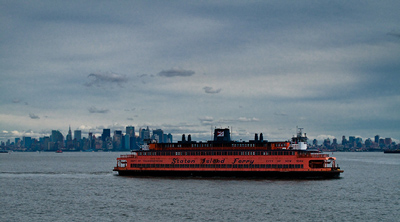 rather than the odd. I would seek, reach, explore and document the old boatyard in Rossville, Staten Island. The perspective of a shoreline graveyard full of ghostly rusted boats forever sleeping in a muddy prison had me jumping up and down like a hungry flea in sight of its dog.
rather than the odd. I would seek, reach, explore and document the old boatyard in Rossville, Staten Island. The perspective of a shoreline graveyard full of ghostly rusted boats forever sleeping in a muddy prison had me jumping up and down like a hungry flea in sight of its dog.
Of course, a reasonable analysis of my project would have revealed inherent flaws and suggested a high percentage of failure probability, but the way I look at it, if Columbus had doubted himself before embarking, he never would have discovered us. We would now be speaking a strange dialect born from a merge between Apachean, Inuit, Quechua and penguin languages. We’d have invented the wheel on our own, last year or the previous, and would soon come up with 8-track audio cassettes and the rotary intersection design. Progress, it seems, always reaches the same dead-ends.
So ignoring the odds, I set out for Manhattan where I caught the Staten Island ferry. The bloody thing is huge, Indonesian catastrophe-size, and it’s got its 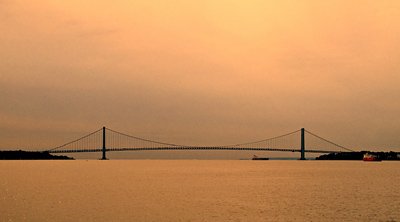 own terminal right at the southern tip of downtown. Painted a strange rusty orange, the boats run back and forth all day, and surprisingly, they are free. The principle is the same as with neighboring Governors Island Ferries: you line up along with hundreds of others, the ferry arrives, spills out its guts, passengers only, no cars, and then it is fed again, and you walk aboard dragged by the human tide, and you find a spot, and you wait for departure, camera in hand, tourist among many, innocent, ready.
own terminal right at the southern tip of downtown. Painted a strange rusty orange, the boats run back and forth all day, and surprisingly, they are free. The principle is the same as with neighboring Governors Island Ferries: you line up along with hundreds of others, the ferry arrives, spills out its guts, passengers only, no cars, and then it is fed again, and you walk aboard dragged by the human tide, and you find a spot, and you wait for departure, camera in hand, tourist among many, innocent, ready.
Granted, it’s from a ferry that one gets the most spectacular views of New York. Trendy Brooklyn, Manhattan in all its shrunk glory, infamous Jersey City, the Statue of Statues, Governorless Island, they all drift by as cameras are whipped around and shutters worked hard. And then Staten Island becomes larger and looses its blurry halo. From a theoretical shape on the map, it morphs into a reality show, gains sharper focus and reveals a first surprise. There’s actually a hill on there. In the land of flatness, this comes as a relief. It will be the last.
The perspective of a shoreline graveyard full of ghostly rusted boats forever sleeping in a muddy prison had me jumping up and down like a hungry flea in sight of its dog.
So when I stepped onto the island, having taken my share of skyline shots, botched the Statue twice, attempted a daring pano and snapped a few boring little-boat-going-nowhere-with-a-purpose pictures, I followed the orderly crowd through an even larger terminal and looked for signs to the train. Happily zapping my monthly NYC transit pass, I was allowed access to a multiple-dock station where a board said the train was “now boarding”. It was an old NYC subway running on subway tracks, but I had good hopes of traveling in broad daylight since digging a tunnel had probably 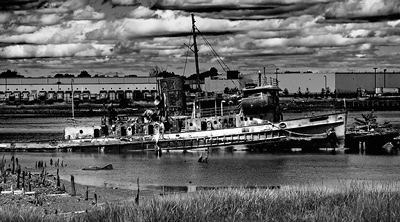 seemed completely unnecessary to the early engineers.
seemed completely unnecessary to the early engineers.
Right away I noticed essential details: very few people on the train, and those few were already showing signs of suburbian difference. The seats were literally engraved with graffiti, car-wide, and I assumed this reflected a latent boredom of the younger generation without the Machiavellianism required for heavier crime. The stops were quick. No time to hesitate; if you got up slowly, you missed your exit. Stations were closely located to each other, though, which could or could not have indicated a stubborn allergy of the culturally inbred local population to the act of walking.
The single Staten Island subway line has 23 stations, straight down to the bottom tip. I was headed to the 17th one, Prince’s Bay, from which I had anticipated a 4 to 5 km walk northward. But there seemed to be a decent bus network and I suddenly hoped to find good wheels to the old keels. So far, it was all going according to plan. Comme sur des roulettes, as we say in French. That would soon change.
I saw nothing from the train, apart from single-family houses and an alarming number of pink flamingos. My station, like all the others, had no gate of any kind. It would seem that on Staten Island, one only pays a train fee when going through the ferry terminal station. I climbed up to street level and looked for the bus stop. 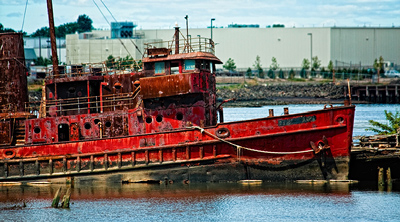 Every stop on the island has a full schedule posted. S55 was scheduled to arrive 19 minutes passed the hour. It appeared at 27 or so. Close enough.
Every stop on the island has a full schedule posted. S55 was scheduled to arrive 19 minutes passed the hour. It appeared at 27 or so. Close enough.
The ride was brief. A single other passenger boarded after me and soon was gone. The end of the line was a correctional institution. I got off a touch before it. Two gigantic and obviously abandoned gas or oil tanks welcomed me from behind a high tree line. I had seen them on Google Maps. I was on track. But 5 minutes later, the track disappeared. Google Maps Street View had revealed a wall but I had hoped for breaks. There were none. The entire area was fenced in.
A sign by an open gate read “Witte Marine – We buy scrap metal”. I peaked in. It was their yard I had been looking for. My naval ghosts rested in the background. A ferocious looking doberman slept under a trailer. I saw no leash. Having run out of options, I walked in and asked for permission to take photos of the boats. Permission was categorically refused to any photographer – category to which I obviously belonged – on the basis of insurance and liability. “Sorry. But thanks for asking,” the man said. The dog relaxed. He wouldn’t have to take care of my ankles after all. Others had skipped the asking part and gotten their legs chewed off but they sure tasted worse than the nightly bone.
I silently swore every bad word I knew in three languages. My carefully crafted plan had come crumbling down the slope of a long boring train ride to nowhere. As a last resort, I asked the man if there was any other non-liable access to the boats. “There’s a small cemetery down the road that way,” he waived. “Some people go there and get a view from across the bay…”
I nodded and thanked and left. I had rarely hated our society 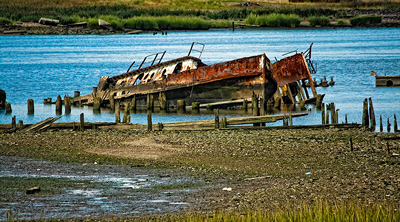 more than at that moment. At the apogee of human stupidity – and cupidity – orbits a wild tendency to sue anybody for anything, in a rare combination of greed and irresponsibility: rather than act carefully and answer for themselves, people, at the first sign of trouble, put the blame on others and launch revengeful lawsuits in hope of life-long richness.
more than at that moment. At the apogee of human stupidity – and cupidity – orbits a wild tendency to sue anybody for anything, in a rare combination of greed and irresponsibility: rather than act carefully and answer for themselves, people, at the first sign of trouble, put the blame on others and launch revengeful lawsuits in hope of life-long richness.
It would seem one is never at fault for getting hurt – the fault is always someone else’s, someone who must pay! The so-called freedom claimed by Americans has actually just about disappeared from their lives, and a good, thick share of it was dropped along with the invention of liability. Somewhere down the line, it was completely forgotten that ultimately, we’re always liable for our own actions. Instead, when it hurts, we just look for someone to blame.
Grumbling, I walked a hundred yards and found the small cemetery. Right off the road, 4 or 5 steps lead up to a few abandoned graves under the deep shade of trees and beyond which a narrow path dropped towards the shore through thick vegetation. I could see a couple of lonely wrecks on the edge of the boatyard. All wasn’t lost. Maybe I could walk along the exposed shore to the nearest hull. I had, after all, 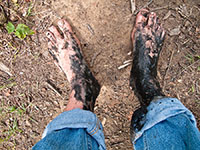 made sure that my expedition coincided with low tide.
made sure that my expedition coincided with low tide.
Having negotiated my way past spider webs and thorns, I arrived on a grassy patch that was humid and spongy but not damp. Garbage had been accumulated there by the tides and I watched my steps carefully as I approached a line of tall plants separating me from the actual river bed, exposed and looking muddy and quite unpleasant. The view towards the left and the liability-conscious scrap yard was blocked by tall barge cadavers but the boats ahead looked promising enough for a closer inspection and photos. They were, however, about 100 meters away and between me and them lay nothing but dark mud.
Now, the Forgotten NY site did mention a certain Andrew N. of Urban Exploration Files and his “near-disaster” getting pictures of the boatyard, but the site is down and I couldn’t investigate. It was also noted that “At low tide you 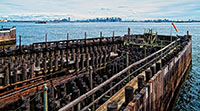 can stroll quite close to the ships, actually, but the sand is loose and can obtain a quicksand-like quality; you run the risk of getting stuck for quite awhile while the tide rushes back in.” But as any good explorer will tell you, until you’ve actually put your hand in a lion’s mouth, you can’t be sure they bite. I hesitated for 10 minutes, perched precariously on a piece of wood in the mud, 5 feet away from the relative hardness of the grass. And then I decided to put my hand in that mouth. Worse. I added both my feet.
can stroll quite close to the ships, actually, but the sand is loose and can obtain a quicksand-like quality; you run the risk of getting stuck for quite awhile while the tide rushes back in.” But as any good explorer will tell you, until you’ve actually put your hand in a lion’s mouth, you can’t be sure they bite. I hesitated for 10 minutes, perched precariously on a piece of wood in the mud, 5 feet away from the relative hardness of the grass. And then I decided to put my hand in that mouth. Worse. I added both my feet.
In a circus-like balancing act, I took off my running shoes and socks, pulled the flip-flops I had brought along for such an occasion, and slipped them on. Then, shoes in one hand and the other balancing the large camera around my neck, I took a careful step forward. The open sandal slid and then stopped, making gurgling noises. I tried to bring it back, my legs now way too far apart, but it refused to break away from the mud and sank a little deeper, disappearing just below the surface. I was now committed.
The other foot went in, with hopes of finding the mud to be shallow. As I stepped, the first foot sank deeper. The second went straight down to mid-tibia. I lost my balance and my free hand landed in the mud. I tried to pull my leg out. At 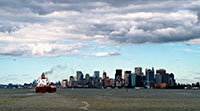 first nothing moved. Mud is incredibly convincing and stubborn. All the quick-sand horror pictures of my youth rushed back at once. Then, gradually, the first foot came back up, without its flip-flop, but with a beautiful suction sound. I had no choice. The free hand was already muddy and didn’t wear the watch, so it dove after the sandal. Having found it, I managed to pull the other leg free while backing up to the piece of wood. An incredible draft of pure sulfur smell rose from the holes I’d created.
first nothing moved. Mud is incredibly convincing and stubborn. All the quick-sand horror pictures of my youth rushed back at once. Then, gradually, the first foot came back up, without its flip-flop, but with a beautiful suction sound. I had no choice. The free hand was already muddy and didn’t wear the watch, so it dove after the sandal. Having found it, I managed to pull the other leg free while backing up to the piece of wood. An incredible draft of pure sulfur smell rose from the holes I’d created.
I looked down. My feet were black up to the rolled up pants. I had dropped the shoes. Both hands were black to my forearms. Mud had splashed as far up as my belt and t-shirt. I looked at the old boats, now as far away from me as the moon might be, and retreated bare feet, shoes in one hand, sandals and a kilo of mud 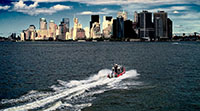 in the other. Going back through the woods, I forgot the spider webs and landed face first in one, jerkily pulling it off my lips and eyes with mud covered fingers that left war paintings.
in the other. Going back through the woods, I forgot the spider webs and landed face first in one, jerkily pulling it off my lips and eyes with mud covered fingers that left war paintings.
I seemed to have randomly picked a superb specimen of the Toxicodendron genus as a scraper.
I set up my emergency camp at the cemetery. The dead would have to bear with me and the smell. Tearing leaves off a low tree conveniently growing at the edge of the swampy area, I extensively scraped mud off my arms and legs while scanning around me for signs of patrols or hilarious laughter. A botanist – and also probably anybody with common sense – would surely have told me with great enthusiasm that I seemed to have randomly picked a superb specimen of the Toxicodendron genus as a scraper. But nobody was around and I carried on dutifully.
I then noticed a car-wash across the road and thought, maybe, just maybe… The guys must have seen me coming. They pointed to the hose. It took me a good 10 minutes to rinse off and make myself semi-presentable. I was drenched from the belt 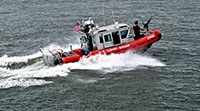 down, pants rolled up, t-shirt soaked. Trying to look dignified, I thanked around and was on my way, shoes hanging from the backpack, flip-flops sounding like their name, toe and fingernails black as coal.
down, pants rolled up, t-shirt soaked. Trying to look dignified, I thanked around and was on my way, shoes hanging from the backpack, flip-flops sounding like their name, toe and fingernails black as coal.
There was a small joint down the road that advertised lunch and coffee. I walked in. I had expected the western movie scene where all patrons suddenly quiet down and stare at the stranger, but few were inside the long dark room and they all ignored me. A bar on one side, a store counter on the other, pool tables at the end. 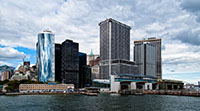 Bizarre place. I badly wanted a beer, but first… “Do you have a…” I asked the man behind the kitchen counter. He was pointing down the hall before I could finish my sentence.
Bizarre place. I badly wanted a beer, but first… “Do you have a…” I asked the man behind the kitchen counter. He was pointing down the hall before I could finish my sentence.
I finished cleaning up, put my shoes back on, unrolled the pants and back at the bar, somberly sipped my beer. The boatyard had eluded me. I caught a bus back down to the train and jumped on the ride home. A couple of inventive kids were using the train’s deceleration and acceleration at each station to propel their scooters back and forth the entire length of the car. I didn’t even care. Bloody liability.
So. Apologies for the lack of boat pictures. It’s much more 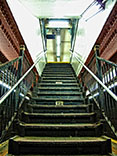 difficult to document failure then success.
difficult to document failure then success.
It has now been three days. The poison ivy has turned both my feet and other places into patchy war zones. Surprisingly, the hands are almost clear. Go figure. I’m trying various home remedies in sequence and keeping track of my progress. So far, there has been none.
Not sure why I went there… I guess I wanted to scratch an itch: see old boats, touch them, bring them back to life through my photography. Well now I’m scratching all right. ;-)
Comments
Marie
dinahmow
donna
Vince
Vince
Vince
Keli'i
Sigrid
Vince
BumbleVee
rachel
Vince